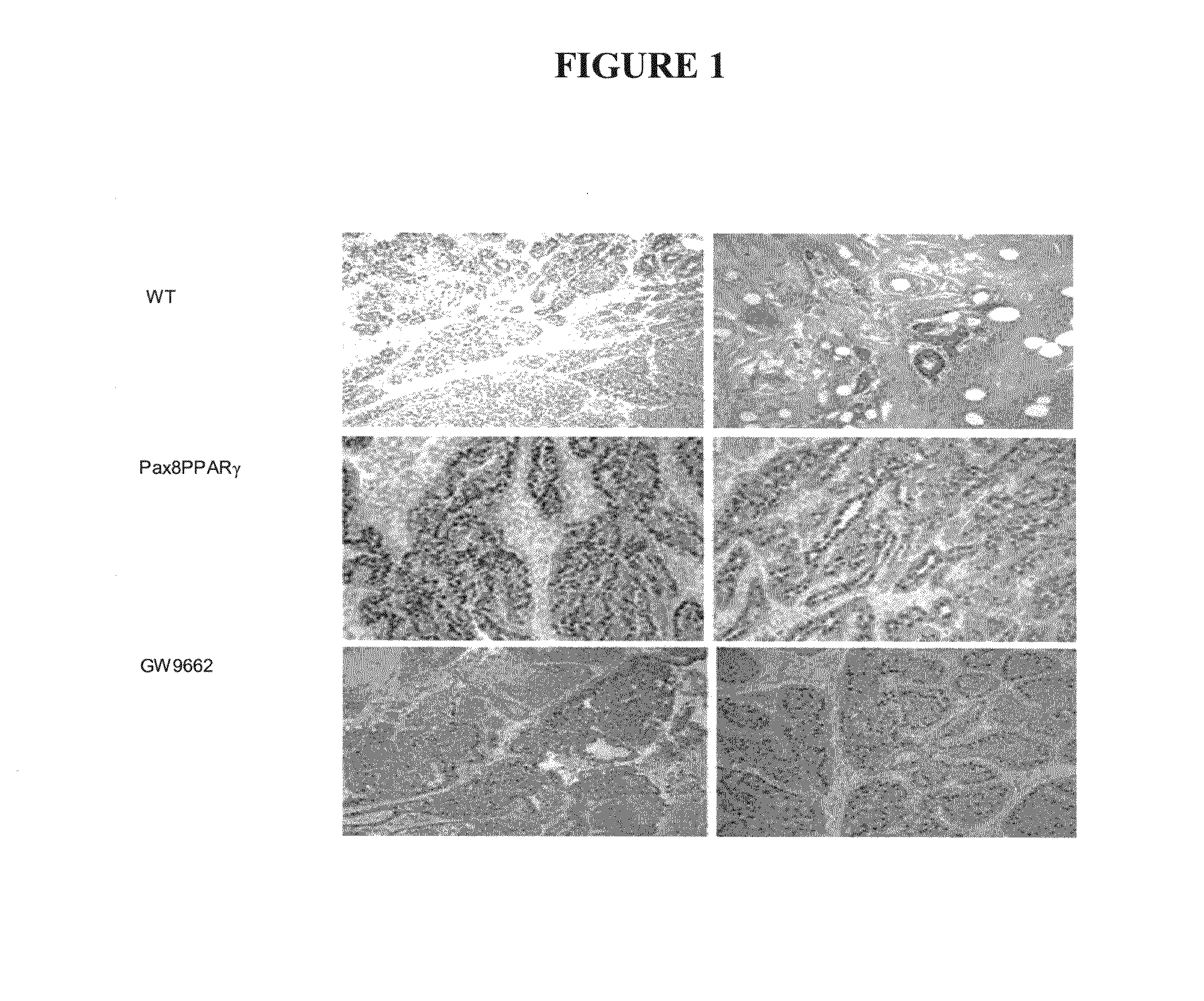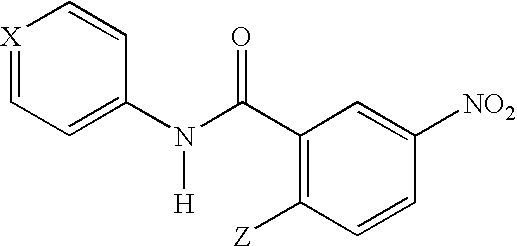Method for the treatment of breast cancer
a breast cancer and treatment method technology, applied in the field of breast cancer treatment, can solve the problems of poor survival outcome of er () tumor patients, and achieve the effect of inhibiting growth and reducing the level of an estrogen receptor transcript or protein
- Summary
- Abstract
- Description
- Claims
- Application Information
AI Technical Summary
Benefits of technology
Problems solved by technology
Method used
Image
Examples
example 1
[0038]Synthesis of GW9662 (2-Chloro-5-nitrobenzanilide).
[0039]To a stirred solution of 2-chloro-5-nitrobenzoyl chloride (5.03 g, 22.9 mmol) and triethylamine (3.51 mL, 25.1 mmol) in CH2Cl2 maintained under nitrogen at 0° C. was added dropwise aniline (2.19 mL, 24.0 mmol). The resulting solution was stirred for 5 min at 0° C. and then for 15 min at room temperature. This solution was then diluted with ethyl acetate (EtOAc) (300 mL) and washed sequentially with 1.0 M HCl, water, 1.0 M NaHCO3, and brine (100 mL each). The organic solution was then dried over MgSO4 and concentrated by rotary evaporation to give a light yellow solid (5.32 g) which was recrystallized from EtOAc to provide the title compound as a white solid (3.34 g, 53%): mp 155-156° C.; 1H NMR (CDCl3, 400 MHz) % 8.63 (d, 1H, J) 2.7), 8.28 (dd, 1H, J) 2.7, 8.9), 7.81 (br s, 1H) 7.68-7.63 (m, 3H), 7.42 (t, 2H, J) 7.9), 7.23 (t, 1H, J) 7.5); MS (ES−) mle 275.1 (MH)−; Anal. Calcd. for C13H9C11N2O3: C, 56.43; H, 3.28; N, 10.1...
example 2
[0040]Mammary carcinogenesis was induced in female wild-type FVB / N or MMTV-Pax8PPARγ transgenic mice purchased from Charles River Laboratories (Wilmington, Mass.) by subcutaneous injection of 600 mg / kg medroxyprogesterone acetate suspension (150 mg / ml, Sicor Pharmaceuticals Inc., Irvine, Calif.), followed one week later by four weekly oral doses of 1 mg dimethylbenz(a)anthracene (DMBA) dissolved in cottonseed oil (10 mg / ml). Following the last dose of DMBA, mice were injected subcutaneously once a week with 40 mg / kg GW9662 dissolved in cottonseed oil (10 mg / ml). GW9662 was synthesized according to Leesnitzer et al., Functional Consequences of Cysteine Modification in the Ligand Binding Sites of Peroxisome Proliferator Activated Receptors by GW9662, Biochemistry 41, pp. 6640-6650, (2002) and provided under a contract with the National Cancer Institute, NIH, Bethesda, Md. The body weight of the mice was in the range of 20 to 25 g at the day of treatment initiation. The mice were healt...
example 3
[0042]Mammary carcinogenesis (see, e.g., Yin et al., Characterization of medroxyprogesterone and DMBA-induced multilineage mammary tumors by gene expression. Mol. Carcinogenesis 42:pp. 42-50, (2005)) was induced in Pax8PPARγ transgenic mice, which mammary carcinomas are ER(+) and were treated once a week for three months with the ER antagonist fulvestrant at a dose of 200 mg / kg administered subcutaneously in an oil emulsion. It was seen that fulvestrant completely inhibited tumor formation in the Pax8PPARγ mice following carcinogenesis. Each experimental group consisted of 6 mice. FIG. 2 indicates the total number of mammary tumors appearing three months after carcinogen administration.
PUM
| Property | Measurement | Unit |
|---|---|---|
| Composition | aaaaa | aaaaa |
Abstract
Description
Claims
Application Information
 Login to View More
Login to View More - R&D
- Intellectual Property
- Life Sciences
- Materials
- Tech Scout
- Unparalleled Data Quality
- Higher Quality Content
- 60% Fewer Hallucinations
Browse by: Latest US Patents, China's latest patents, Technical Efficacy Thesaurus, Application Domain, Technology Topic, Popular Technical Reports.
© 2025 PatSnap. All rights reserved.Legal|Privacy policy|Modern Slavery Act Transparency Statement|Sitemap|About US| Contact US: help@patsnap.com



